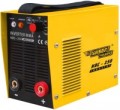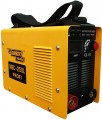Min. welding current
The smallest current that the device is able to supply through the electrodes during operation. For different materials, different thicknesses of the parts to be welded and different types of welding itself, the optimal welding current will be different; there are special tables that allow you to determine this value. The general rule is that a high current is far from always useful: it gives a rougher seam; when working with thin materials, it is possible to melt through the junction instead of connecting the parts, not to mention excessive energy consumption. Therefore, if you have to work with parts of small thickness (2-3 mm), before choosing a welding machine, it makes sense to make sure that it is capable of delivering the desired current without “busting”.
Duty cycle
The duty cycle allowed for the welding machine.
Almost all modern welding machines require breaks in operation — for cooling and general "recovery". The frequency of inclusion indicates what percentage of the time of the total work cycle can be used directly for work. In this case, 10 minutes is usually taken as a standard cycle. Thus, for example, a device with a duty cycle of
30% will be able to work continuously for less than 3 minutes, after which it will need at least 7 minutes of interruption. However, for some models, a cycle of 5 minutes is used; these nuances should be clarified according to the instructions.
In general, high frequency is required mainly for high-volume professional work; with a relatively simple application, this parameter does not play a decisive role, especially since you have to take breaks during work. As for specific values, the mentioned 30% is a very limited figure, typical mainly for entry-level devices. A value of
30 – 50% is also low; in the range of
50 – 70% is the majority of modern devices, and the most "hardy" models provide a frequency
of more than 70%.
More features
—
Hot start. A function that facilitates arc ignition: when the electrode touches the welding spot, the welding current increases for a short time, and when the machine enters the mode, it returns to standard parameters.
—
Forcing the arc (Arc Force). Devices with this function are able to increase the welding current with a critical reduction in the distance between the electrode and the parts to be welded. This increases the rate of melting of the electrode and the depth of the weld pool, which helps to avoid sticking.
—
Protection against sticking (Anti-Stick). In this case, a protective measure is implied in case sticking of the electrode still could not be avoided: the automation of the welding machine significantly reduces the welding current (or even turns it off), which makes it easy to disconnect the electrode, and in addition — to avoid unnecessary energy consumption and overheating devices.
—
Decreased voltage x. X. (VRD). This function is used to significantly reduce the open circuit voltage of the machine. When the VRD is turned on, the open electrodes receive not a standard voltage of several tens or even hundreds of volts, but only 9-12 V. At the same time, the operating parameters are restored automatically — when the electrode touches the workpiece and a high current occurs; and when the arc is e
...xtinguished, the voltage again drops to the minimum values. This format of work provides two main advantages. Firstly, it provides additional safety: in particular, closing contacts with a hand or other part of the body does not lead to a serious electric shock, and the risk of such an injury in high humidity is also reduced. Secondly, lower voltage helps to save energy.
— Pulse welding. Usually, this refers to gas-shielded arc welding (MIG / MAG or TIG), carried out in the so-called pulsed mode. With this format of operation, the main welding current, which is relatively low, is supplemented by high-power pulses (7-10 times higher than the background current), which follow at a frequency of several tens per second. There are also various modifications of the pulse mode, with more complex current control; however, the basic principle remains the same. Anyway, the advantages of pulsed welding are the uniformity of both the arc itself and the resulting seam, as well as an improvement in the overall quality of the joint: pulses help to mix the metal in the weld pool and eliminate pores, oxides and other defects. The disadvantage of this function is traditional — an increase in the cost of welding machines.
— 2/4-stroke mode. Possibility to choose the control mode of the device — two-stroke or four-stroke. This allows you to further adjust the control to the specifics of the situation. Recall that in push-pull mode, the device works while the button is pressed, and turns off when it is released; this is especially useful for short seams and other similar tasks when welding does not need to be switched on for a long time. In turn, with a four-stroke control format, the first press-release turns on welding, the second turns it off. This method is indispensable for long-term work, when it would be tiring to keep the button pressed all the time.
— Synergetic management. A function mainly used when operating in the pulse mode described above. Synergic control can also be called "intelligent": it is carried out using built-in electronic microcontrollers that control most of the settings and automatically change them if necessary. In fact, it looks like this: it is enough for the welder to set a number of inputs (type and thickness of the material, composition of the shielding gas, wire thickness, etc.), and based on this, the machine will automatically select the optimal operating parameters (output voltage, pulse configuration, feed rate wire, etc.). Moreover, if one of the inputs changes in the course of work, the other parameters of the work change accordingly.
Synergic control greatly simplifies the operation of the device and at the same time improves its quality, reducing the likelihood of burns and other serious errors. This is especially convenient for inexperienced welders who are not accustomed to dealing with fully manual parameter settings; however, even professionals appreciate the ease and speed of adjustment that is characteristic of synergic models. The main disadvantage of this feature is that it has a significant impact on the cost.
— Digital display. The presence of its own display in the design of the welding machine. This is, usually, the simplest segment screen, designed to display 2 – 3 digits and some special characters. However, even such screens are more informative than light and other similar signals: they can display a wide variety of data (input and operating voltage, time until shutdown "to rest", error codes, etc.). And the advantages over dial indicators are in small size and versatility — the display can display different types of information. As a result, this function can greatly simplify the work with the welding machine.
— Connector for the remote control. Connector for connecting a remote control to the device. Depending on the model, we can talk about both traditional hand controls and foot pedals. Anyway, such an accessory provides additional convenience in some situations — in particular, it allows you to turn the power on and off, and even change individual operation parameters, without approaching the device every time. However most often welding machines are supplied without a remote control — however, this gives certain advantages: you can choose such an accessory at your discretion (the main thing is to make sure it is compatible).
— Liquid cooling. Presence of a liquid cooling system in the configuration of the welding machine. Such cooling is more efficient than air cooling, it intensively removes heat from the hardware of the apparatus, the burner and allows you to achieve a very high duty cycle (see above) — up to 100%, and at currents of 200 A or more. Its disadvantages are complexity, high cost, bulkiness and significant weight. In light of the latter, liquid cooling units are often made separately from the welding machines themselves and can be connected / disconnected depending on what is more important at the moment — efficient cooling or portability. Also note that for many models, the manufacturer recommends using specialized coolants, and they are most often not included in the delivery set.
— Built-in compressor. Compressor for air supply built directly into the machine. This feature is found only in models operating in PLASMA mode. Recall that this mode involves cutting metal using a powerful jet of highly heated and ionized air; To create the desired pressure, a compressor is needed. It can also be external; however, the built-in compressor allows you not only to always have all the necessary equipment with you, but also to reduce the overall dimensions of this equipment. In addition, with such equipment, you do not need to worry about the compatibility of the device and the air supply system. The disadvantages of models with built-in compressors include the increased cost, as well as the dimensions and weight of the entire body.
— Starting the car engine. The ability to use the device to start the car engine, namely to power the starter. In other words, models with this function are also able to work in the launcher mode. Such an opportunity will be useful if the regular car battery is dead, out of order or missing, but there is a power source (mains or generator) nearby from which you can power the welding machine. Note that most often in this case it means the launch of cars with 12-volt on-board networks — cars, light trucks and buses; however, technically, nothing prevents to provide compatibility with heavy equipment (trucks, buses) operating on 24 volts. These details should be specified separately.
— Transport wheels. The presence in the design of the welding machine of special wheels that facilitate transportation. The weight of some modern models can reach several tens of kilograms, and it is difficult even for several people to carry such a device manually. The presence of wheels makes it possible to manage by the forces of one person, even with a significant weight of the unit.Case (bag) included
The presence of a
case or bag for storage and transportation in the scope of delivery of the welding machine.
Cases are characteristic hard containers in the form of a suitcase; such containers provide excellent protection against moisture and dirt, as well as against impacts. Bags, in turn, are made soft; they are inferior to cases in terms of the quality of protection, but they are less bulky and can be folded quite compactly when not needed. Well, anyway, complete packaging usually turns out to be more convenient and practical than impromptu.

